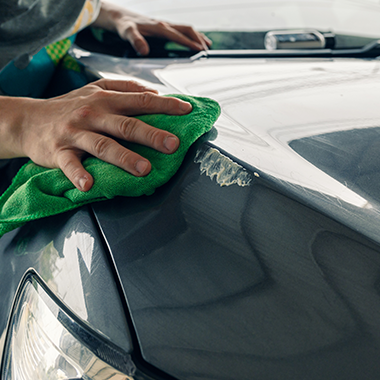Car waxing

Waxing the car's body is one of the most popular methods for rejuvenating the paint and enhancing the appearance of a vehicle. The mirror-like shine is just the beginning of the benefits. Car wax provides protection for the paint against environmental factors, reduces dirt adhesion, improves the visual condition of the paint, and safeguards the body from impurities. The protective layer shields the paint from dust, tiny rust particles, bird droppings, and various other contaminants. Hard wax on the car's surface also imparts a glass-like effect, enhancing the car's appearance. To achieve the best results when waxing a car, the paint should first be decontaminated and polished, allowing the wax to adhere better to the surface.
Tips
Before applying wax, all impurities and residues from old protective layers must be removed. The product should be applied to a clean and degreased surface, as any irregularities and imperfections may interfere with the process.
Synthetic wax usually has greater durability than natural wax. Among natural products, carnauba wax, derived from the leaves of the carnauba palm, offers the highest durability. Natural wax is valued for its visual properties.
Wax is applied using a special sponge or a microfiber applicator. It can also be done with a polishing machine.
How to apply wax? Most manufacturers recommend applying wax in circular motions. It can also be done using a polishing machine and dedicated pads.
Care should be taken not to apply a layer of wax that is too thick, as this will make it difficult to achieve a high gloss with a microfiber cloth.
To check whether the wax has dried and can be polished with a cloth, it is helpful to perform a "finger test." If the wax stretches and resists, it is advisable to wait a bit longer.
The frequency of car waxing depends on the wax's durability and the vehicle's care routine. The most durable synthetic waxes can last up to a year, but most products maintain their effectiveness for approximately 2-3 months. This can be determined by observing water beading and sheeting on the car's surface.
Beginner detailing enthusiasts often start their waxing journey with inexpensive products, but this may not be the best choice. Professional wax is easy to apply and provides longer-lasting protection than cheaper alternatives.
To effectively protect your car, waxing should be repeated at least every six months.
Wax should not be applied in full sunlight or on a hot surface. In extreme cases, this can result in stains on the paint. Waxing the car's body is best done in the shade or in a garage, with the optimal air temperature at around 20 degrees Celsius.
Car owners with a protective coating should also remember to use high-quality car care products when washing their vehicle. Strong cleaning agents can wash away the protective layer and deteriorate the paint's condition.
Scope of services
Cleaning and drying the car
Multi-stage or one-step paint correction using an electric polisher
Removing deeper scratches and paint touch-ups
Decontamination of the paint - chemically and mechanically cleansing the paint from embedded contaminants
Preparing the car for waxing (washing, decontamination, paint correction)
Application of car wax or other protective products (ceramic coatings, sealants, quick detailers, polishes)
Renewal of the wax layer
Selection of wax suitable for the specific type of paint
The most durable waxing method is the dry application. Wet wax tends to last on the surface for a very short time.
Find a car workshop
Check out our workshops that offer the service car waxing in some of the biggest cities in your country
Additional info about the service
To ensure effective protection against external factors, waxing a car should take several factors into account. First and foremost, the car must be thoroughly washed and then dried. Applying wax to a dirty or greasy surface would not only be ineffective but could also damage the clear coat. Removing embedded contaminants requires the use of professional car care products, such as deironizers or tar and asphalt removers. In many cases, using a clay bar for mechanical cleansing of the paint is necessary.
After washing and drying the car, it is essential to inspect the car's body that will be waxed. Scratches, chips, or signs of corrosion may hinder or even prevent the wax application. Therefore, professional detailing studios perform a full paint correction before waxing, using polishes of different gradations. While scratch removers are available, they are not as effective. They often contain fillers that only visually conceal imperfections. Correction provides lasting effects and allows for greater precision. Removing chips and corrosion spots is more challenging and often requires intervention from a professional painter. Only when the paint is ready can the wax be applied.
What Does Waxing Your Car Offer?
Why is waxing your car worth it? Wax protection adds shine and rejuvenates the paint, giving it a deep color and a "wet car" effect. Additionally, it provides a hydrophobic layer, causing rainwater and contaminants to slide off the vehicle. As a result, car maintenance becomes much easier as contaminants do not adhere to the surface of the body. High-quality wax protects the paint from oxidation, dullness, and fading.
How much does car waxing cost?
The price of a good wax is not high, and for around 100-150 PLN, you can buy a long-lasting product that will serve you for many years. However, preparing the body for waxing requires the use of many other products, which is why entrusting the task to professionals may be more cost-effective. A detailing studio will apply wax professionally, provide advice on how to wax your car during regular maintenance, and suggest ways to maintain the effects. A quick detailer spray used in a touchless car wash can extend the wax's durability by several months. However, if you prefer to wax your car yourself, you can easily find step-by-step guides on waxing a car on the Internet.